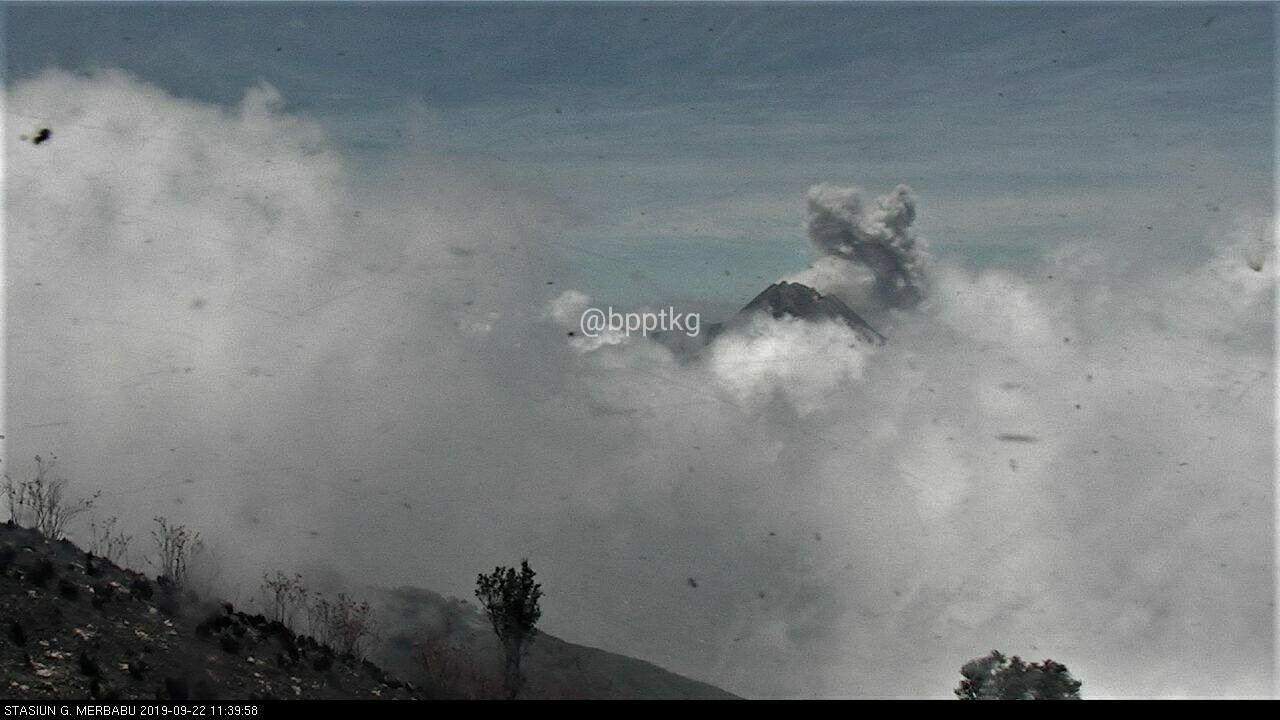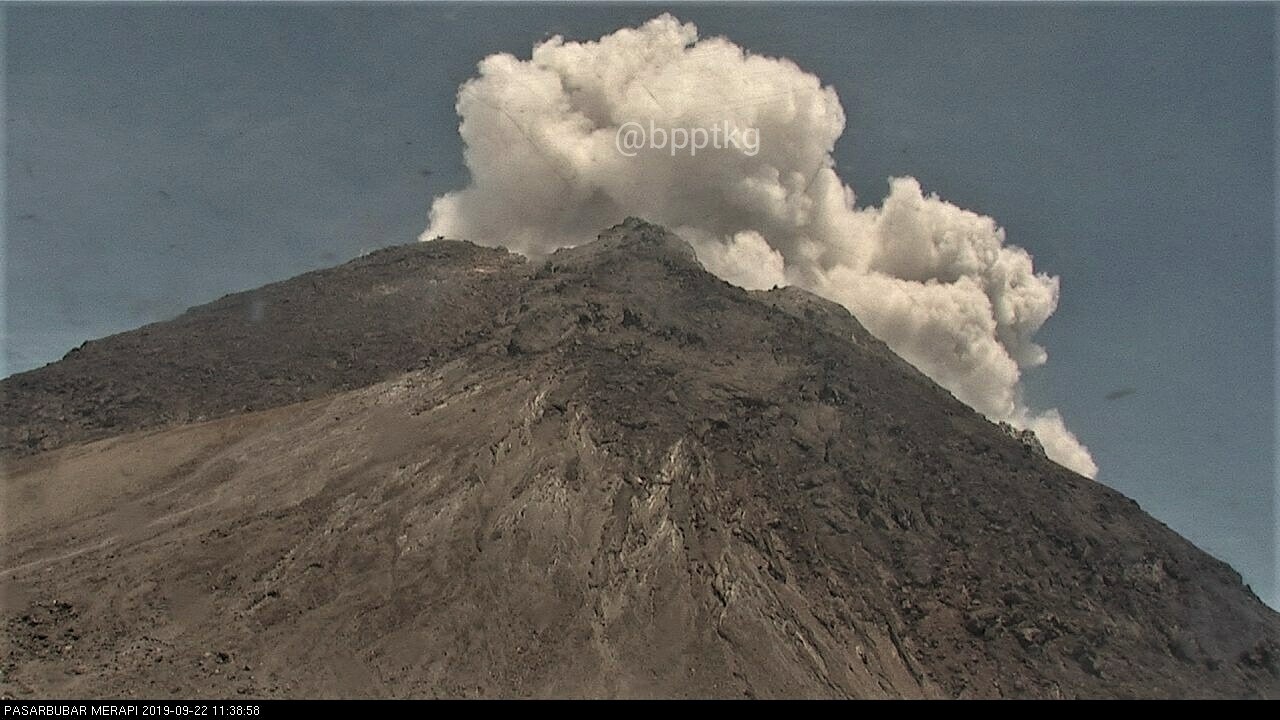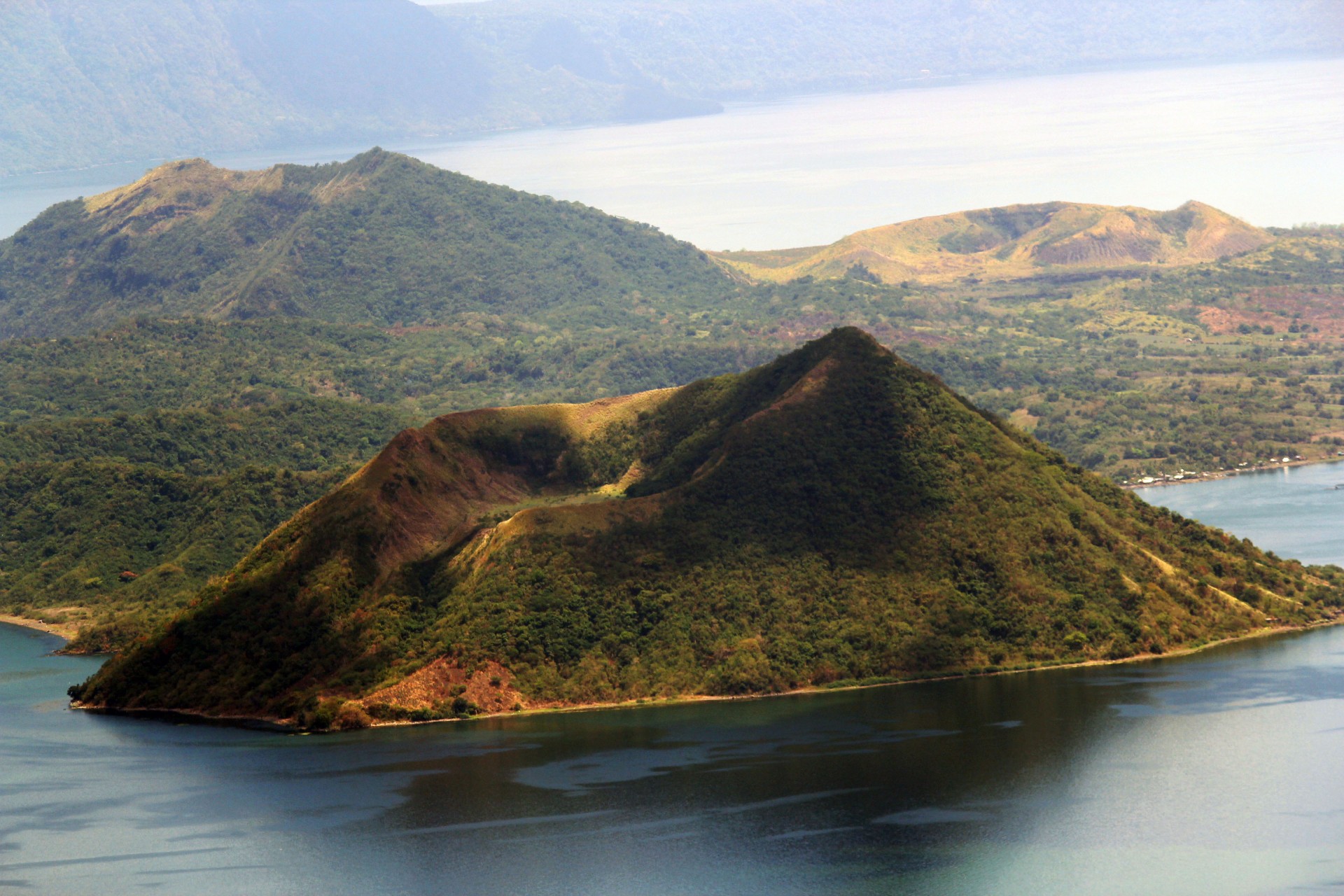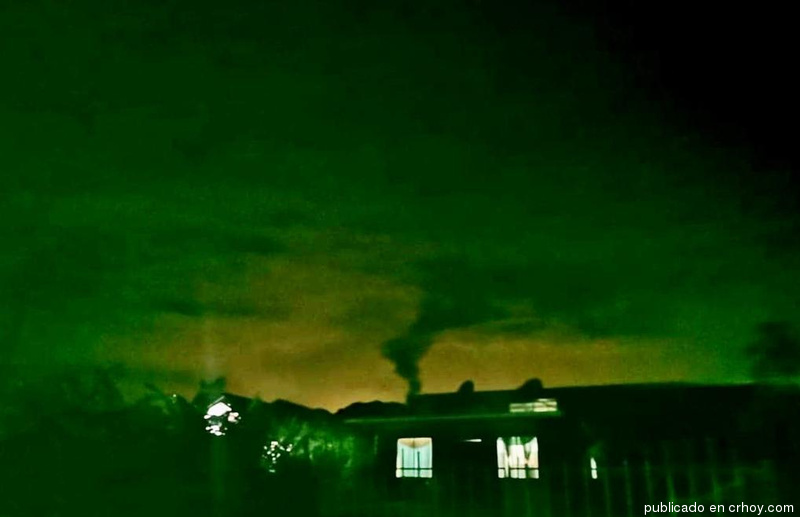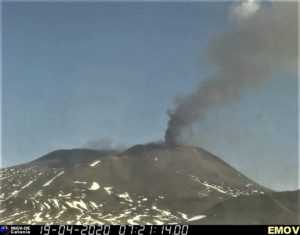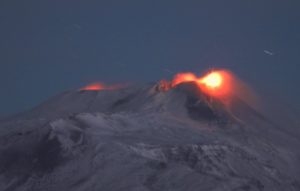September 23 , 2019.
Indonesia : Merapi ,
Eruption with hot avalanche clouds of G. Merapi on September 22, 2019.
On Sunday, September 22, 2019 at 11:36 WIB, hot clouds were recorded on a seismogram with an amplitude of 70 mm and a duration of 125 seconds. The distance of hot clouds is estimated at 1200 m. Monitoring was conducted from Merbabu video surveillance, showing a column of eruption smoke up to ± 800 m from the summit. To anticipate volcanic ash disruption for air traffic, an orange VONA (Aviation Volcano Observing Notice) code has been issued. Light ash rains have been reported around Mount Merapi within a radius of 15 km mainly in the Southwest sector.
Unlike an avalanche (APG), a common phenomenon since January 29, 2019, this time the hot cloud was preceded by an eruption of gas and was therefore a hot cloud eruption (APL). The APG is caused by the collapse of new lava dome materials by gravitation or without significant initial velocity. During the APL, the collapse of the lava dome material is due to the gas pressure coming from the inside. As the supply of magma continues, volcanic gas is produced continuously. Due to the dynamic pressure, the ducts can become clogged and the gases accumulate under the lava dome and break off abruptly, which breaks it up and breaks it down into a hot cloud.
An increase in gas pressure can be detected by the monitoring station. From 12:00 to noon, there were 29 earthquakes and 14 explosions. The number of earthquakes and explosions is relatively high, which represents an increase in the pressure and intensity of the release of volcanic gas. This is consistent with the lava dome temperature monitoring data about 1 hour before the eruption, which showed an increase in temperature at several locations on the lava dome, around 100 ° C. decreased and calmed down after the LPA until now.
Both APG and APL will always occur, as the magma supply is still in progress, which is indicated by the occurrence of earthquakes from within such as VTA, VTB, and earthquakes. MP in large quantities. The threat of danger caused by eruptive activity is always the same, namely the emission of hot clouds and the emission of eruptive materials within a radius of 3 km around the summit of Mount Merapi. The results of the modeling show that if the current lava dome (461,000 m3) collapses, the sliding distance of hot clouds does not exceed a radius of 3 km.
Society must remain calm and active as usual. For official information on Mount Merapi’s activities, the public can access the information through the nearest Mount Merapi observation post, via 165.075 MHz radio frequency, on the website www.merapi. bgl.esdm.go.id, on BPPTKG social media or at BPPTKG office in Jalan Cendana No. 15 Yogyakarta, phone (0274) 514180-514192.
Source : Hanik Humaida / Chef du BPPTKG
Read the article : http://merapi.bgl.esdm.go.id/pub/page.php?idx=410
Chile , Nevados de Chillan :
Special volcanic activity report (REAV) of the Ñuble region, Nevados de Chillán Volcanic Complex 22 September 2019, at 01:30 local time (mainland Chile).
The National Geological and Mining Service of Chile (Sernageomin) discloses the following PRELIMINARY information, obtained through the monitoring equipment of the National Volcanic Monitoring Network (NVRN), processed and analyzed at the Volcanological Observatory of the South Andes (OVDAS) ):
Yesterday, Sunday, September 22 at 01:05 local time (04:05 UTC), the control stations installed near the Nevados Volcanic Complex of Chillán recorded an explosion related to the dynamics of the fluids inside the volcanic system with emission of gas and particles.
The characteristics of the earthquake are as follows:
TIME OF ORIGIN: 01h05 local time (04h05 UTC)
LATITUDE: 36,869 ° S
LONGITUDE: 71,381 ° W
DEPTH: 0.5 km
REDUCED MOVEMENT: 506 cm2
ACOUSTIC SIGNAL: 3 [Pa · Km].
OBSERVATIONS:
The explosion produced a column of gas and particulate materials of low height. At the time of publication of this report, seismicity continues, although the reduced displacement values are lower.
The volcanic technical alert is maintained at the Orange level.
Source : Sernageomin.
Photo : Ovdas.
Philippines , Taal :
TAAL VOLCANO BULLETIN 23 September 2019 8:00 A.M.
Taal Volcano’s seismic monitoring network recorded thirty-two (32) volcanic earthquakes during the 24-hour observation period. One of these earthquakes occurred at 12:49 PM yesterday was felt at Intensity I with rumbling sound at Calauit and Pirapiraso, eastern and northern sector of the Volcano Island, respectively. Another earthquake, which occurred at 03:50 AM today was felt at Intensity II with rumbling sound at Pirapiraso and Intensity I at Alas-as, western sector of the Volcano Island. Field measurements on 19 September 2019 at the western sector of the Main Crater Lake yielded an increase in water level, from 0.39 meters to 0.49 meters. Ground deformation measurements through precise leveling surveys from 15 – 24 June 2019 indicated slight inflation of the edifice consistent with recent results from continuous GPS data.
Alert Level 1 remains in effect over Taal Volcano. This means that hazardous eruption is not imminent. The public, however, is reminded that the Main Crater should be strictly off-limits because sudden steam explosions may occur and high concentrations of toxic gases may accumulate. The northern portion of the Main Crater rim, in the vicinity of Daang Kastila Trail, may also become hazardous when steam emission along existing fissures suddenly increases. Furthermore, the public is also reminded that the entire Volcano Island is a Permanent Danger Zone (PDZ), and permanent settlement in the island is strongly not recommended.
Source : Phivolcs.
Photo : publicdomaine.
Costa Rica , Poas :
Poas Volcano Activity Report, 22nd September 2019.
On 22 September 2019 at 20:59 local time, an eruption was recorded on the Poas volcano, with a column that rose to 3000 meters above the crater and 5708 meters above sea level. (18722.24 ft) .
Duration of the activity: in progress.
Ash fall reported in: No ash fall reported
Sulfur odor reported in: No sulfur odor reported
Comments: Eruption on the Poás volcano with an eruptive column rising more than 2 km high. The wind is blowing in the northeast.
The National Emergency Commission ordered the closure of Poas Volcano Park this Monday.
Source : Ovsicori.
Photo : crhoy.com

